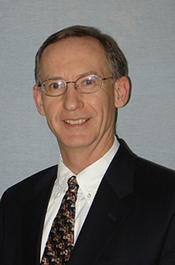North Carolinas Renewable Energy Portfolio Standard (REPS) has encouraged investments in renewables and the energy economy statewide.
ABB and Smart Grid Technology in North Carolina
Gary Rackliffe | ABB
How is ABB currently contributing to North Carolina’s energy economy?
ABB is one of several North Carolina-based companies that is driving advancements in technology and serving the energy industry. ABB’s North American headquarters are located in Cary, North Carolina, but our statewide footprint goes far beyond a corporate office. Manufacturing, research, development and demonstrations are all taking place across the state. Our power products and systems businesses are both located in North Carolina. At our Pinetops, North Carolina facility, we manufacture sensors, current transformers, cutouts and other distribution equipment. ABB’s Smart Grid Center of Excellence, where we’re able to demonstrate our technological capabilities in-person, is located on N.C. State’s Campus in Raleigh. Our Corporate Research Center is located in Raleigh, as well.
What makes North Carolina’s energy industry a national leader?
North Carolina’s energy economy has become one of the largest and most diverse nationwide for a number of reasons. The state is home to the Research Triangle Cleantech Cluster; ABB is one of the founding board members. The Research Triangle Cleantech Cluster brings together area companies that are driving major technological advances in smart energy, smart cities, analytics and distributed energy resources. In Charlotte, there is another trade association called E4 Carolinas. Between the Research Triangle Cleantech Cluster and E4 Carolinas, North Carolina has a strong base of energy companies that are industry leaders and developing exciting, new technologies. All of these companies want to grow on an individual level and expand the state’s energy sector overall. Our efforts are supported by leading universities and utilities, including N.C. State, University of North Carolina Charlotte, University of North Carolina Chapel Hill and Duke Energy.
What renewable energy sources have the most potential for growth in North Carolina?
Solar and wind power are playing increasingly important roles in North Carolina’s energy economy. This, in large part, is due to policies like the Renewable Energy Portfolio Standard, wind production tax credits and solar PV investment tax credits which encourage investment in these areas.
What policies will help North Carolina’s energy economy grow and thrive?
North Carolina’s Renewable Energy Portfolio Standard (REPS) has encouraged investments in renewables and the energy economy statewide. Additionally, production tax credits have led to more developments in the wind industry. In order to sustain this type of interest and growth among renewable sources, North Carolina’s energy policies must remain consistent and provide certainty for investors. Wind production tax credits in particular pose problems because they are subject to renewal by the federal government, and aren’t always in place. On the consumer side, we need to implement policies that incentivize them to use energy in a way that improves grid operability and efficiency.
What is ABB’s role in smart grid technology?
ABB plays a fundamental role in smart grid technology. When properly implemented, smart grid technologies increase efficiency in production, transport and consumption; improve reliability and resiliency; integrate renewable power into the grid to improve sustainability; and increase economic efficiency through electricity markets and consumer participation.
The most advanced smart grid technologies are in electrical transmission, and ABB is the market and technology leader in many of them, including:
-
High-voltage direct current (HVDC) technology delivers long-distance power with low losses on land and underwater, and connects asynchronous grids.
-
Flexible alternative current transmission systems (FACTS) devices enable existing transmissions to deliver maximum power, and help stabilize the grid with precise power control.
-
Wide area monitoring systems (WAMS) track critical system parameters to prevent development of dangerous network instability.
-
Supervisory control and data acquisition (SCADA) systems analyze real-time grid conditions, providing data for fast power adjustments.
-
ABB technologies for smart distribution networks and buildings include: building automation systems, electric vehicle charging equipment, solar inverters, high-efficiency distribution transformers and substation and feeder automation.
Describe ABB’s presence in North Carolina.
The ABB Group of companies operates in roughly 100 countries and employs about 140,000 people. North America is the largest market for ABB products and services, with headquarters in Cary, North Carolina. ABB employs around 1,900 at eight locations across North Carolina. Our Global Research and Development Center for Electric Power is located on North Carolina State University’s Centennial Campus, along with our Smart Grid Center of Excellence.

About Gary Rackliffe
Gary Rackliffe is the Vice President of Smart Grids at ABB. He leads ABB's smart grid initiatives in North America and is the General Manager of the Smart Grid Center of Excellence in Raleigh, North Carolina. Gary has 30 years of Transmission and Distribution (T&D) experience, working for ABB in Raleigh the last 20 years in management, strategic marketing, and business development positions.
Gary currently chairs the National Electrical Manufacturers Association (NEMA) Smart Grid Council, is ABB’s representative for the GridWise Alliance, and is a member of the DistribuTECH Advisory Committee, the International Electrotechnical Commission (IEC) Smart Energy Systems Committee, and the Research Triangle Cleantech Cluster Advisory Committee.
Gary holds a Bachelor of Science and Master degrees in Power Engineering from Rensselaer Polytechnic Institute and a MBA from Carnegie Mellon. He is a Registered Professional Engineer and an IEEE (Institute of Electrical and Electronics Engineers) Senior Member. He has co-authored a T&D planning book, and has written numerous technical papers.
The content & opinions in this article are the author’s and do not necessarily represent the views of AltEnergyMag
Comments (0)
This post does not have any comments. Be the first to leave a comment below.
Featured Product

